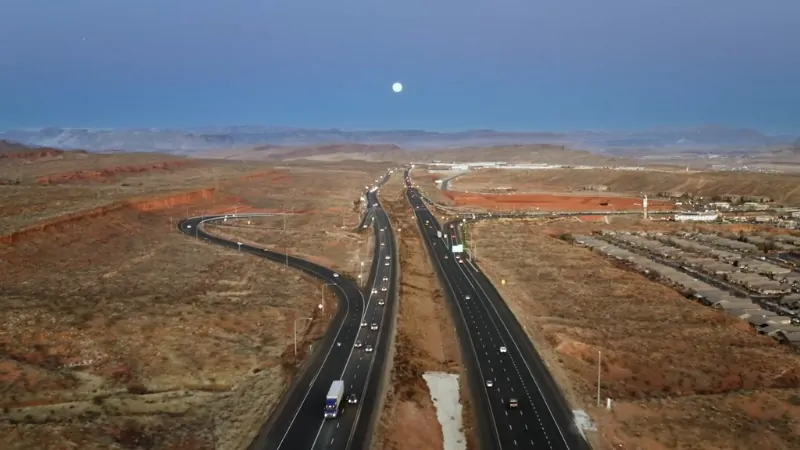SALT LAKE CITY — Utah has once again ranked among the five fastest-growing states in the nation this year, as the U.S. recorded its largest population increase in two decades, according to newly released federal data.
Utah added just over 60,000 residents between July 1, 2023, and July 1, 2024, pushing its population past 3.5 million, the Census Bureau reported Thursday. This 1.8% growth rate ties Utah with Texas for third place among all U.S. states, districts, and territories.
“We’re really fortunate to live in a state where people want to be … because we have the best economy in the nation,” said Gov. Spencer Cox, highlighting the state’s achievement.
Nationwide, the U.S. population grew by 3.3 million during the same period. The 1% increase, the largest since 2001, pushed the total population past 340 million, driven by two major factors.
However, some cities like New York are dropping rapidly amid the high cost of living.
How Utah’s Population Expanded in 2024
Metric
Value
Utah’s population growth rate
1.8%
Net migration contribution
~60% of total growth
International migration share
~90% of net migration
Natural increase (births-deaths)
~24,000 new residents
Percentage of Utahns 18+ (2024)
73.4%
States with larger growth
D.C. (2.2%), Florida (2%)
States matching Utah’s growth
Texas (1.8%)
The Census Bureau’s annual estimates don’t pinpoint the exact causes of population changes or explain why some states grow faster than others. Instead, they provide insights through data on natural increase—births minus deaths—and migration patterns.
Net migration, especially from other states, has driven Utah’s population growth in recent years. This factor helped Utah lead the nation in percentage growth between the 2010 and 2020 censuses. However, its ranking has declined slightly in recent years, dropping to ninth in 2023 due to a 1.1% growth between 2022 and 2023.
In 2024, trends held steady, with net migration accounting for about 60% of Utah’s annual growth. Notably, international migration made up over 90% of that migration, according to Census Bureau data.
Utah is once again one of the five fastest-growing states this year, while the U.S. experienced its largest population spike in two decades. https://t.co/0hwQhEtKT4
— KSL 5 TV (@KSL5TV) December 19, 2024
Christine Hartley, assistant division chief for estimates and projections at the Census Bureau, highlighted improvements in tracking immigration data that have enhanced understanding of international migration’s role in overall population growth.
Utah also saw a natural increase of nearly 24,000 residents from births outpacing deaths. This ratio of migration to natural increase may explain why the percentage of Utahns aged 18 or older rose from 72.7% in 2023 to 73.4% in 2024.
After accounting for all factors, Utah climbed back into the top five fastest-growing states in 2024, tying Texas with a 1.8% growth rate. Only the District of Columbia (2.2%) and Florida (2%) had higher growth, while South Carolina (1.7%) rounded out the top five. Nevada (1.7%), Idaho (1.5%), and Arizona (1.5%) also ranked among the top 10 growing western states.
Utah Misses Top 10 in Numeric Growth
Utah failed to break into the top 10 in numeric population growth this year, a position it has occasionally reached in past years.
Texas led the nation, adding over 500,000 new residents, followed by Florida (467,347), California (232,570), North Carolina (164,835), and New York (129,881).
Arizona and Washington also exceeded 100,000 new residents each, contributing to the presence of Western states in the numeric growth rankings.
In contrast, only four areas—Mississippi, Puerto Rico, Vermont, and West Virginia—reported population declines over the past year.
More detailed population estimates, including data on metropolitan areas, counties, cities, and towns, as well as demographic shifts across the country, are expected to be released next year.
Balancing Growth Challenges
Utah Governor Spencer Cox acknowledged both the benefits and challenges of the state’s population growth during a monthly briefing with reporters.
While Utah’s growth highlights its economic strength, Cox noted the strain it places on housing, water resources, transportation, and other infrastructure.
“This does present a challenge, but I would always encourage us to avoid those false choices that we can’t grow … and preserve a high quality of life,” Cox said. “We can do both of those things.”
He emphasized that the state continues to adapt to its growing population, addressing issues such as immigration and crime. Cox also reiterated his support for federal efforts to deport undocumented immigrants who have committed crimes, a topic gaining renewed attention as the new presidential administration prepares to take office.
Reflecting National Trends

Utah’s population trends closely mirror national patterns. Net migration remained the dominant factor in the U.S.’s population growth in 2024.
Natural increase—births exceeding deaths—added 519,000 people to the national total, a significant recovery from pandemic-era lows.
This figure is more than triple the natural increase recorded in 2021, the lowest in U.S. history.
The country’s overall population grew by 1% in 2024, a sharp rise compared to recent years.
Census Bureau demographer Kristie Wilder explained this shift, noting the growing importance of migration over natural increase in driving population growth.
“What stands out is the diminishing role of natural increase over the last five years, as net international migration has become the primary driver of the nation’s growth,” Wilder said. This year’s data underscores the rapidly changing dynamics of U.S. population growth.








